
You might have heard of influencer marketing, and you’re interested in launching your first campaign. The problem is you’re a bit lost on how to get started, and you’re not sure which types of influencers will be right for your campaign.
When it comes to influencer marketing, bigger doesn't always mean better. In fact, a recent study found that micro-influencers may be the best choice if you want to reach a highly engaged audience and maximize conversions.
In this post, you’ll get an in-depth look at micro-influencer marketing, including tips on finding the right ones for your brand and ways to launch a successful campaign with them.
Let’s dive in!


Who are Micro-Influencers?
Micro-influencers are influential, knowledgeable individuals who usually have between 1,000 and 100,000 followers.
According to a study by Dr. Jonah Berger from the Wharton School and the Keller Fay Group, the leading authority on word of mouth marketing research,
Micro-influencers are not traditional celebrities, but rather individuals who work in their category or are truly knowledgeable, passionate and authentic and are seen as a trusted source when it comes to recommendations for what to buy.

The Benefits of Working with Micro-Influencers
Before you launch a campaign with a micro-influencer, you have to be sure you’re working with someone who can provide you with what you need. This means looking at the benefits of working with these influencers and comparing these benefits with your actual goals.
So let’s take a closer look at some of the ways in which your brand can benefit from working with a micro-influencer:
1. Engagement
One of the defining assets of micro-influencers is how well they can engage with their audience. In fact, they generate a much higher engagement rate than top influencers with millions of followers. This makes them an ideal choice for brands who wish to reach a highly engaged audience.
Markerly conducted a study of more than 800,000 Instagram users, among which most of them had a minimum following of 1,000 people. Their study of approximately five million posts led to the discovery that the more followers someone has, the lower their engagement rate.
The study found that users who don’t even have 1,000 followers still manage to get post likes from 8 percent of their followers. Users who have more than ten million followers only get post likes from 1.6 percent of their followers.
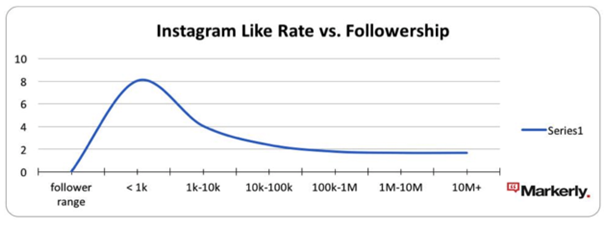
When it comes to comments, users who have less than 1,000 followers are able to get post comments approximately 0.5 percent of their followers. But for those with more than 10 million followers, the difference in average post comment rate is 13 times lower, at only about 0.04 percent.
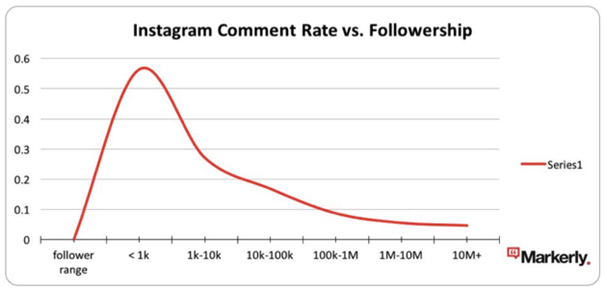
2. Trustworthiness
Micro-influencers gain a following from people who consider them to be experts in their respective categories. For instance, people who are interested in food and dining may follow a home cook, a restaurant owner, food stylist, or other individuals who know something about food or dining. Followers have more trust in recommendations and tips when they’re coming from a relevant influencer.
 A study by Dr. Jonah Berger and the Keller Fay Group
A study by Dr. Jonah Berger and the Keller Fay GroupAdditionally, as many brands want to work with influencers who have massive reach, they usually choose macro-influencers over micro-influencers. This means most micro-influencers don’t create as many sponsored posts as top influencers. When they do vouch for a brand or product, their recommendation comes off as more authentic and trustworthy.
3. Cost-effectiveness
If you’re a startup or a small business, working with micro-influencers may be your best bet as micro-influencers don’t charge as much as top influencers or celebrities for sponsored posts.
A Takumi report published in Marie Claire UK found that influencers with 1000+ followers charge about £40 (50 USD) per post. The cost per post rises as the number of followers rises. For instance, a post from an influencer who have 5000+ followers would cost you about £75 (93 USD) and a post from an influencer with 20,000+ followers would cost you about £300 (372 USD).
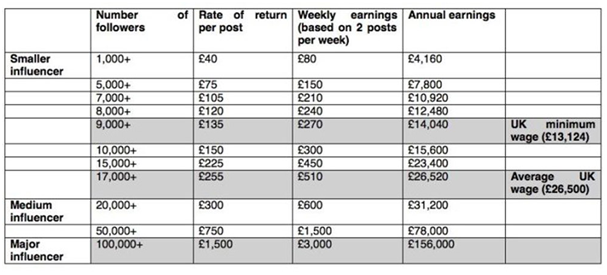
These numbers suggest that working with smaller influencers can be much more cost-effective. If you work with influencers with more than 500,000 followers, you might even have to spend about 3000 USD for one sponsored Instagram post. For videos and extensive blog posts, the cost could go much higher, and might even reach as high as 5000 USD.
So if you have a limited budget to work with, you could seek help from smaller influencers who have sufficient reach and a highly engaged audience. In many cases, you might even be able to find micro-influencers who would work for you in exchange for freebies alone.
These benefits mean that launching a campaign with micro-influencers would be best if you are looking for high levels of engagement. It’s also a viable solution if your goal is to win the trust of your target audience. And it’s especially ideal if you have to launch a campaign on a limited budget.

The Challenges of Working with Micro-Influencers
Although there are plenty of ways brands can benefit from working with micro-influencers, there are a few reasons why working with them may not be ideal for you. This largely depends on what you wish to achieve from the campaign.
1. Limited reach
Micro-influencers have a sufficient and highly-engaged following. But they don’t have the kind of reach top influencers have. Top-tier influencers can connect with millions of people at a time, but micro-influencers can only reach a few thousand fans at once. Your campaign may be unable to reach the desired amount of people due to this limited reach.
So if your main goals are to drive brand awareness and boost your visibility, working with micro-influencers might not be the best choice for you. If you have the budget to spend on sponsored posts from top-level influencers, you could work with both micro- and macro-influencers for the right balance of reach and engagement.
2. Ineffective content
Micro-influencers may not get as many sponsorship or promotion offers as their top-tier counterparts. Some of them may not be used to doing promotions for brands and/or creating sponsored content.
As a result of this, there’s a chance that the content they create will sound overly promotional or inauthentic. They may try too hard to promote your products or services, and stray from their natural voice.
The best way to solve this is to provide influencers with creative freedom, instead of trying to control everything they do. Encourage them to do their best to integrate your products or services seamlessly into their usual content, rather than trying too hard to promote the items.
3. Lower ROI
Although micro-influencers are much less expensive to work with, there’s a chance your marketing dollars won’t deliver the ROI you’re looking for because of the limited reach mentioned earlier.
You could take a risk and invest in a few micro-influencers to help promote your business. But your campaign could still fail because the influencers you’ve chosen are unable to promote your products or services effectively.
Here’s where your choice of influencers will make all the difference. Look for micro-influencers who have done a few promotions or partnerships with brands, as they would already get the gist. But try to avoid micro-influencers who have already done a lot of promotions because you want to preserve authenticity.
Additionally, you can offer micro-influencers freebies of your products or services (instead of monetary compensation) in exchange for reviews or promotional posts. Based on the performance of those initial efforts, you can then consider other compensation options.

What to Look for in a Micro-Influencer
Now that you’ve decided to launch a campaign with micro-influencers, your next move is to find the influencers you’ll be working with. But before you start looking for them, you need to have a clear idea what to look for in a prospective influencer.
Although your final choice may depend largely on your goals and what type of industry you’re in, here are the basic qualities you should look for in an influencer:
1. Relevance
Is the influencer relevant to your business? Will they be able to seamlessly promote your product with their usual content? For example, a gaming influencer talking about a new gadget or a new line of gaming merchandise would be considered relevant.
Nitrolado Ice Cream promoting themselves through a food and lifestyle influencer like Ashley Yi (18.4k followers) is an excellent example.
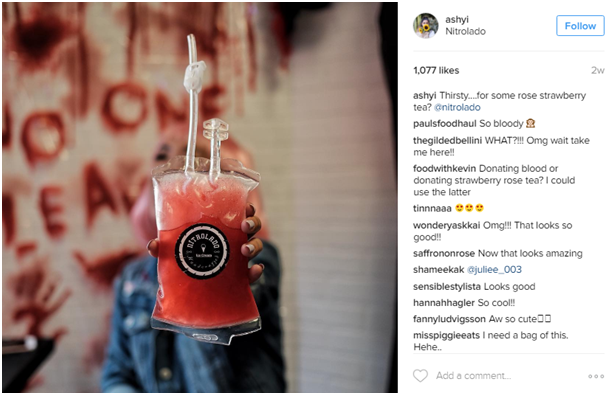
The whole point of working with micro-influencers is to reach an audience that will engage with your brand. And for an audience to engage with your brand, they need to be interested in what you have to offer. This means you need to promote your products through an influencer whose followers share similar interests with your target audience.
2. Content quality
Does the influencer produce high-quality content? This could be in terms of grammatical correctness, picture quality, and so on. You want your brand to be represented in a positive light. To do so, you’ll need to present your products through high-quality images and descriptive captions.
Not every micro-influencer produces high-quality content consistently. Just because an influencer has a high number of followers, it doesn’t mean that they will produce better content than an influencer who has fewer followers. During your search for the ideal influencer, go through their regular content to see whether the quality aligns with your expectations.
For instance, Rob Petrone is a five-time Emmy-winning host and executive producer of “Restaurant Hunter.” Although he has just over 2,000 followers on Instagram, he regularly posts high-quality images related to the food and dining industry.
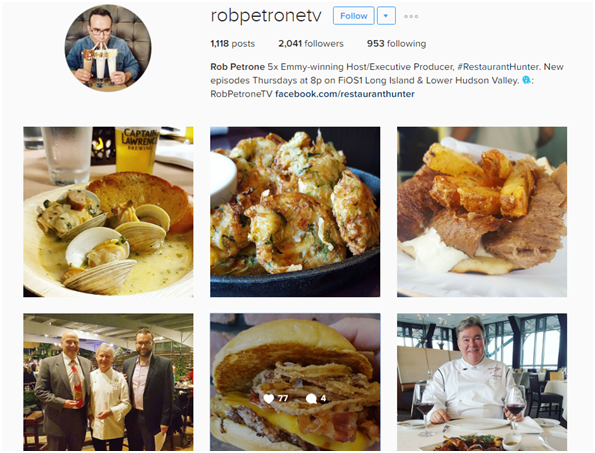
3. Ability to engage
It’s true that micro-influencers have a higher engagement rate than macro-influencers. At the same time, not every one of them would engage their audience properly. One of the main reasons you’re working with micro-influencers is because you’re looking for better engagement. So it would be wise to carefully look through an influencer’s content and see how well she engages with her audience.
Take a look at the number of likes and comments they get on their Instagram posts. Are they responding well to comments and questions?
Check out Instagram foodie influencer, One Hungry Girl, for instance. She has just over 3,500 followers, but her photos always manage to generate more than 400 likes and several comments. That’s a like rate of about 11.4 percent, which is highly impressive. She also replies to fan comments and engages with them regularly.

4. Voice/tone of content
There are thousands of potential micro-influencers out there for you. But among those influencers, which one of them fits your brand personality and “vibe” most? Some influencers may have a goofy and comical personality, infusing some fun and humor even in their sponsored content. They would be ideal if your brand prides itself on its laid-back attitude and fun work ethic.
Similarly, you could look for influencers with a serious tone of content delivery if your brand has a more professional personality. And if you’re promoting eco-friendly products, you could try to look for influencers who are well known for their carefree and eco-conscious attitude. You have to figure out your brand personality and then figure out what tone of content delivery would resonate well with your target audience.
For instance, MVMT Watches is a luxury watch brand that relies on influencer promotions. The brand prides itself on a classy yet modern vibe. So their choice of influencers includes lifestyle influencer Little Lily (2,266 followers), who regularly promotes high fashion products and uses pop-culture-influenced captions.
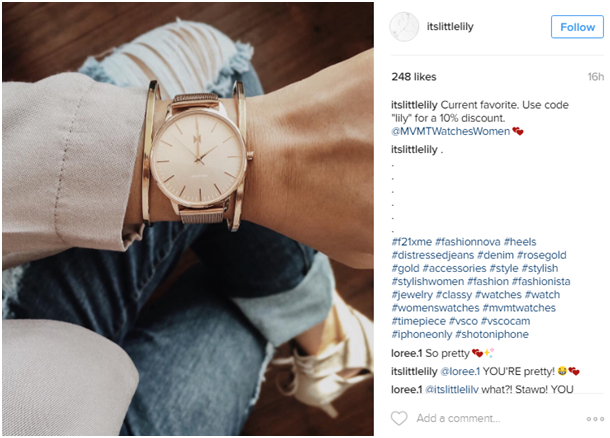

The Best Types of Instagram Micro-Influencers (And How to Find Them)
Even among micro-influencers, there are different subcategories. When you decide to work with one, figure out which of these categories will be best for your brand. Here are the three best types of micro-influencers you can work with and how you can find each of them:
1. The Fan
These are micro-influencers who are already fans of your brand. And if they’re your fans, there’s a huge chance that they’re already following you on social media. You can find them by going through your list of followers, and checking out the profiles of users who seem most relevant to your brand. The easiest tell is their username and/or profile picture.
For example, if you’re a restaurant or a food brand, you might want to check out followers with “food” or “foodie” in their username. Let’s take a look at the follower list for Righteous Foods, a clean food eatery. The list contains someone whose username is @thatfoodiegirl, who could be a potential influencer.
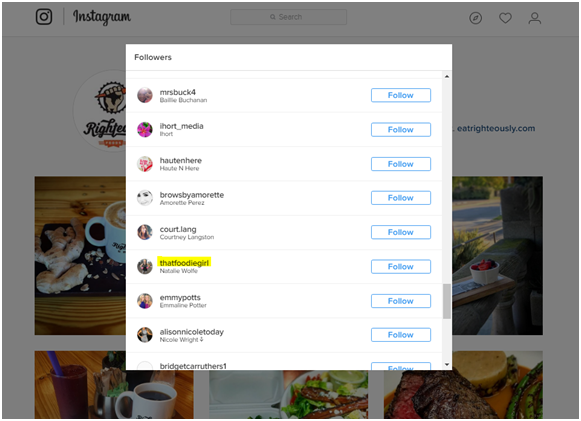
If you go through her profile, you’ll see that she has just over 1,450 followers, and her content is mostly concerned with fitness and food. This means she might be just the right micro-influencer to work with for Righteous Foods.
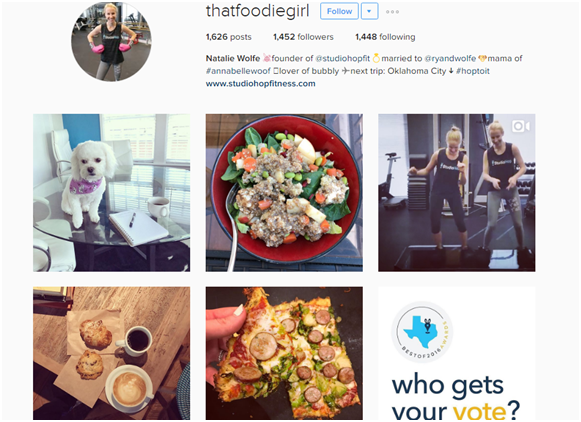
The best part about working with this type of micro-influencer is that you won’t have to spend your time and effort in winning them over. They already like your products, so it will be easier to convince them to promote those products. In fact, you might be able to strike a deal with them to work for you in exchange for free products and samples.
2. The Niche Influencer
These are influencers relevant to a certain niche market. They may have never heard of your brand before, but they may be interested in working with you if your product is relevant to their followers. A study by CrowdTap found that 44 percent of influencers are motivated to work for a brand if the opportunity is relevant to their audience. Working with this type of micro-influencers would be beneficial for you since they already have a loyal following of your target audience.
The easiest way to find these influencers is by conducting a hashtag search on Instagram. For instance, searching for the hashtag #organicbath will lead you to the posts made by brands and influencers related to that hashtag. One of the results is a photo by Deenise Glitz, an eco-conscious, green blogger with more than 1,400 followers. She could be a good micro-influencer for a brand promoting eco-conscious products.
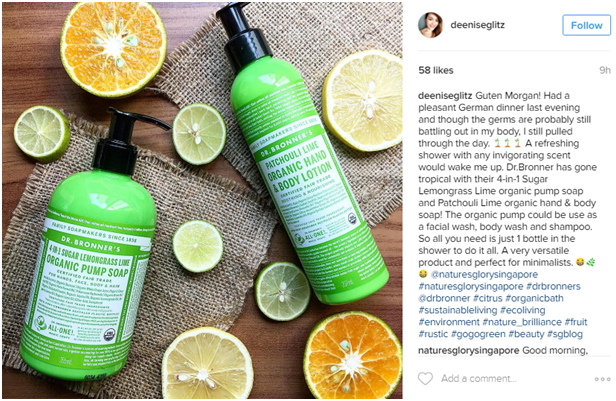
3. The Local Blogger
Many small and local businesses may be interested in promoting themselves through a micro-influencer in a specific location. In such cases, working with local bloggers is ideal because their audience would be highly targeted and relevant to the business.
To find some of the best local bloggers, a simple Google search with the location name can help you find resources, and articles listing potential bloggers you can work with.

After you identify local bloggers you want to work with, search for their Instagram profiles. If they have a sufficient following on Instagram, and you feel like they’re a good fit for your campaign, reach out and get connected with them. You could start a partnership in which they help you promote your business through Instagram and their blog.

How to Work with Micro-Influencers
In terms of campaigns and tactics, working with micro-influencers is just like working with regular influencers. But there are some strategies that work well with micro-influencers specifically:
1. Send them freebies in exchange for honest reviews
Micro-influencers are known for their authenticity, which means working with them can help you win the trust of your target audience. In order to preserve this authenticity, you can encourage micro-influencers to give an honest review about the free products you’ve sent them.
This could work better than sponsoring an entire post, which may seem overly promotional and out of place compared to the usual content produced by the influencer. IDUN Minerals used this tactic, and sent one of their eyeshadow palettes to beauty influencer Mandy Lee, who has 17,500 followers on Instagram.
The influencer provided her followers with an honest review about the product and some information about the brand. She also took care to mention that although she received the product for free from the brand, the opinions she shared were 100 percent her own.

2. Promote store openings or events with local influencers
Local Instagram influencers are an excellent channel for spreading the news about your store opening or event to potential customers in the area. Invite these local influencers for a preview or sneak peek at your store and have them showcase their experiences on Instagram, invite their fans to visit your store, or participate in the event.
DonerG, a California-based restaurant, promoted their grand opening through local food Instagrammers like Paul Castro, who has more than 46,900 followers. The influencer helped promote the store’s special offer, inviting fans to stop by the restaurant for a chance to win a free Turkish ice cream.

3. Promote discount codes to drive conversions
This tactic is important in any kind of influencer marketing. Although influencers can encourage fans to visit your website to buy your products, some people may still hold back from making a purchase.
Give those people a good reason to buy your products by offering them a good deal, such as a discount. Have a micro-influencer post an image of your products and include a unique discount code so that their fans can buy the products.
Fashion e-commerce store, Talis Collection, decided to partner with style influencer Lori, who has a following of just over 3,000. The influencer posted images highlighting some of the clothing available at the store, along with a discount code for 15 percent off to further encourage her followers to make a purchase.
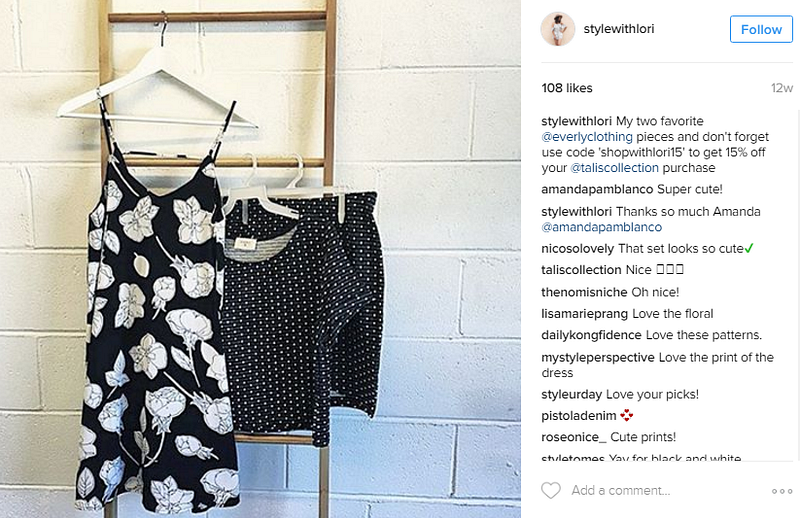

Conclusion
Now you have an in-depth understanding about micro-influencers and how they can benefit your brand. You’re also aware of the challenges involved in working with them. Additionally, you’re prepared with the necessary knowledge to find the right micro-influencers to help promote your brand.
The next step is to come up with a plan, and start looking for potential influencers you can work with. If you need any guidance in planning your influencer marketing campaign, feel free to respond to this post with your questions.

Thank you. It is must learn topic on "SMO"
ResponderBorrar